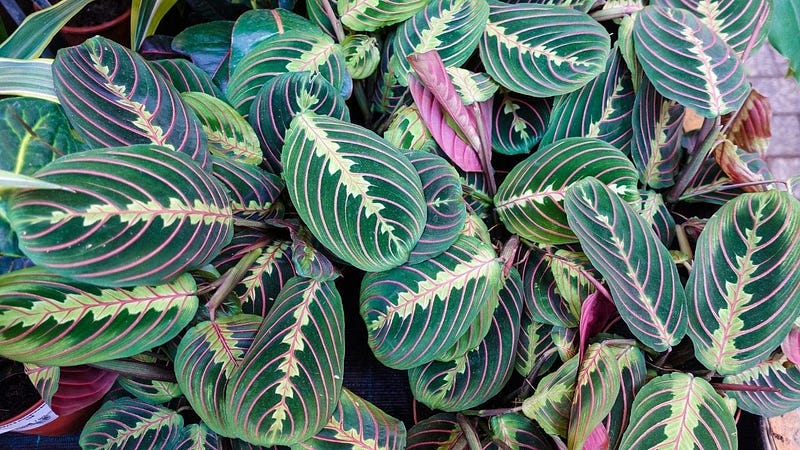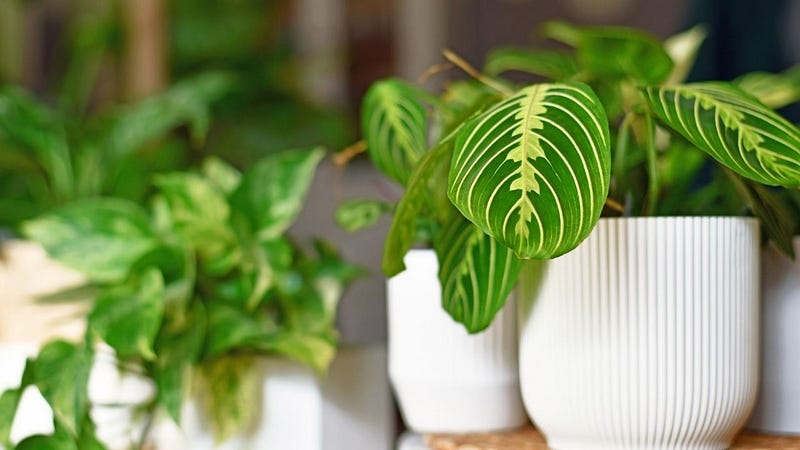
The prayer plant derives its popular name based on the fact that its foliage lie flat throughout the day then curls upwards resembling praying hands by nighttime.
Because of its magnificent ornamental leaves, the prayer plant is amongst the most easily identified tropicals. Vibrant green glossy leaves featuring yellow smudges along the midrib as well as soaring red veins running to the leaf edges distinguish the renowned tricolor type. The prayer plant is a slow-growing interior plant that can develop up to a foot tall.
For proper Prayer plant care its important to maintain low light indoors. They are sensitive towards direct sunlight and hence can burn easily. Water them regulary when you find its top soil little dry. Although overwaetering is not recomended. Add good quality ferliliser mostly ornanic and home made like nitrogen, calcium, good quality soil can make your Prayer plant plant really heathy.
They’re very typical as houseplants, plus they could be potted as well as managed for any season of the year. However, they’re not always simple to maintain and develop over time. This guide will assist you in providing proper prayer plant care and growth hacks.
Top 7 Prayer Plants Benefits
When it pertains to peculiar houseplants, prayer plants are at the top of the list. Here are some of the advantages of cultivating the Prayer plant which may persuade you to do so as well.
1. Distinctive Appearance
Plants which are hot themes among urban gardeners are continuously on the search. The prayer plant’s distinct look renders it an excellent addition to any plant collection. Following the sun setting, the leaves curl vertically then unfold anew as the sun rises, giving the plant another unique feature.
2. Varieties with a Wide Range of Colors
With so many varieties, there’s no way you’ll grow tired of this plant. Red, Lemon, lime, Marisela, Kim, Green, as well as Black, are some of the colourful variants of the Prayer plant.
3. Symbolism
The vertical arching leaves of the prayer plant are shaped like hands clasped in prayer. This feature of the prayer plant represents thankfulness. It also represents appreciation and gratefulness when given as a gift. It is said to offer beneficial energy and great luck in various cultures.
4. Pollutants are absorbed
According to NASA's clean air research, certain houseplants can help to decrease toxins like formaldehyde and benzene throughout the air.
The prayer plant, on the other hand, was not on the list, although it is extremely likely that it eliminated these toxins as well. According to CNBC, indoor air contamination might be even more hazardous than outside air contamination.
5. Health Advantages
It’s a recognized truth that being surrounded by plants makes us feel calm and concentrated, and indeed the Prayer plant is no exception.
Aside from that, research has proven that having plants in the office boosts efficiency and attention. In addition, as stated in several researched guides, healing from disease and damage is accelerated when a plant is nearby.
6. Easy to Maintain
City residents always have a lot on their minds, thus it’s no wonder that many choose low-maintenance houseplants. The prayer plant is indeed a low-maintenance houseplant that doesn’t demand much attention. The Prayer plant needs just strong indirect sunlight, a well-draining medium, as well as high moisture to thrive.
7. It only takes up a little amount of space
The Prayer plant, with a length of 10–12 inches as well as a dispersion of 15–18 inches, is excellent for modern environments often with little area.
It can fit nearly any place, including the , terrace, windowsill, porch, kitchen, and bathroom. It also thrives in deep or flat pots due to its deep root systems.
How To Care For Prayer Plants Indoors + Outdoors

Prayer plant care is as follows.
Your prayer plant should be hung or placed beside a window to obtain filtered sunlight. Avoid placing your plant under direct sunlight since it will burn its leaves, causing them to form blotches or spots and fading in color vibrancy.
Reduced sunlight regions are typically tolerated by prayer plants. Supply strong light to the plants throughout the winter, when they fall into hibernation (and occasionally die back entirely), to keep them growing.
As far as the soil is well-draining, prayer plants may thrive in a range of conditions. A standard potting mix might usually be enough, yet you may prepare your own by mixing up two components: succulent peat moss, one portion loamy soil, as well as one portion of perlite or gritty sand.
Furthermore, the medium must have a pH value of 5.5 to 6.0. Put pebbles or gravel to the base of your planter to enhance the outlet, and make certain the pot has plenty of ventilation openings.
Hydrate your maranta plant often ( anytime the upper surface appears dry) and don’t ever permit the potting medium to dry up entirely throughout their growth period. Drought-susceptible, these plants can not thrive if left unwatered for lengthy periods of time.
To minimize fungal issues, avoid letting water stay excessively on the leaves or allowing the plant to become wet. The leaves might change color and fall off the plant due to both a lack of water as well as overwatering.
Apply water that is at best room temperature, though maybe not somewhat warmer, while hydrating your prayer plant.
4. Temperature and Humidity
Temperatures somewhere around 60 to 80°F are ideal for prayer plants. Temperatures that have been lowered over a considerable length of time might harm the leaves, causing them to fall off the plant. Prayer plants, on the other hand, like a humid climate.
Set a modest mister near the area or put the plant upon a tray loaded with tiny stones as well as water to enhance the moisture accessible to your plant. You may also spray the foliage with room temperature even mildly warm water on a regular basis.
5. Fertilizer
the prayer plant every 14 days from early springtime to late fall (once per month throughout wintertime) using a half-strength liquid potted plant fertilizer is also part of caring for the prayer plant.
The plant will develop gradually or not at all when you utilize insufficient fertilizer. Nevertheless, excess fertilizer can cause the plant’s roots to be burned, its leaves to become yellow, and also the plant to end up dying.
6. Common Pests
Prayer plants, the same as numerous other potted plants, are susceptible to spider mites as well. You could cure your plant using a natural pesticide like neem oil when you see indications of infection, like a chalky white material on the foliage or yellowing of the leaves.
These plants are either non-dangerous or have no recognized toxicity. So they are safe for you and your pets.
Read more and complete the article here.




